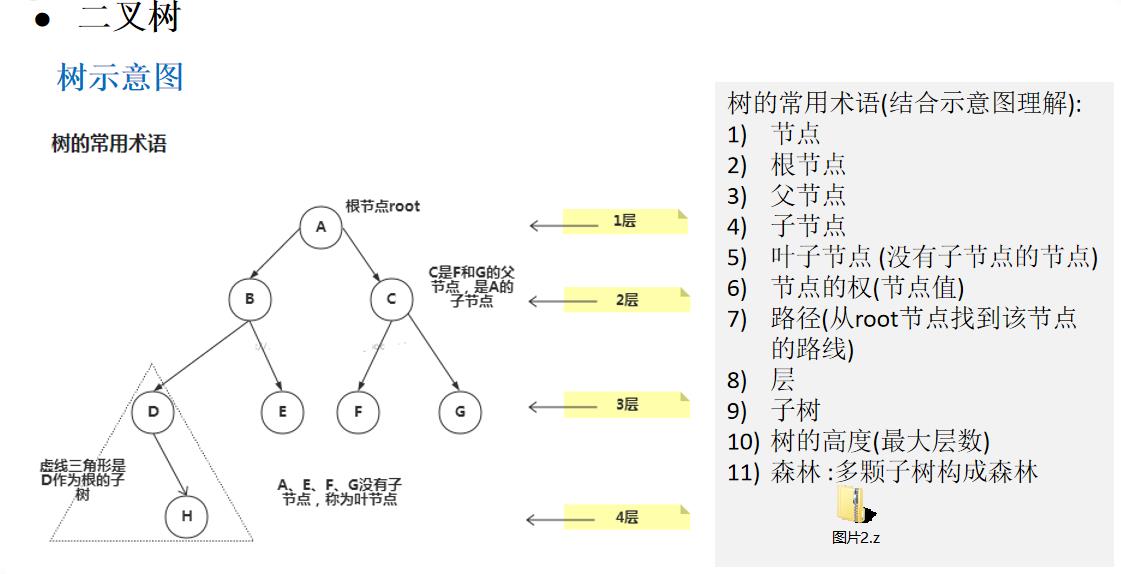二叉树的遍历和遍历查找及删除
Posted 冷血~多好
tags:
篇首语:本文由小常识网(cha138.com)小编为大家整理,主要介绍了二叉树的遍历和遍历查找及删除相关的知识,希望对你有一定的参考价值。
为什么需要树这种数据结构 ?
数组存储方式的分析 优点:通过下标方式访问元素,速度快。对于有序数组,还可使用二分查找提高检索速度。 缺点:如果要检索具体某个值,或者插入值(按一定顺序)会整体移动,效率较低 [示意图] 链式存储方式的分析 优点:在一定程度上对数组存储方式有优化(比如:插入一个数值节点,只需要将插入节点,链接到链表中即可, 删除效率也很好)。 缺点:在进行检索时,效率仍然较低,比如(检索某个值,需要从头节点开始遍历) 【示意图】 树存储方式的分析 能提高数据存储,读取的效率, 比如利用 二叉排序树(Binary Sort Tree),既可以保证数据的检索速度,同时也可以保证数据的插入,删除,修改的速度。

二叉树的概念
- 树有很多种,每个节点最多只能有两个子节点的一种形式称为二叉树。
- 二叉树的子节点分为左节点和右节点。
- 如果该二叉树的所有叶子节点都在最后一层,并且结点总数= 2^n -1 , n 为层数,则我们称为满二叉树。
- 如果该二叉树的所有叶子节点都在最后一层或者倒数第二层,而且最后一层的叶子节点在左边连续,倒数第二层的叶子节点在右边连续,我们称为完全二叉树。


二叉树遍历的说明
前序遍历: 先输出父节点,再遍历左子树和右子树
中序遍历: 先遍历左子树,再输出父节点,再遍历右子树
后序遍历: 先遍历左子树,再遍历右子树,最后输出父节点
小结: 看输出父节点的顺序,就确定是前序,中序还是后序
///编写前序遍历的方法
public void preOrder()
System.out.println(this); //先输出父结点
//递归向左子树前序遍历
if(this.left != null)
this.left.preOrder();
//递归向右子树前序遍历
if(this.right != null)
this.right.preOrder();
//中序遍历
public void infixOrder()
//递归向左子树中序遍历
if(this.left != null)
this.left.infixOrder();
//输出父结点
System.out.println(this);
//递归向右子树中序遍历
if(this.right != null)
this.right.infixOrder();
//后序遍历
public void postOrder()
if(this.left != null)
this.left.postOrder();
if(this.right != null)
this.right.postOrder();
System.out.println(this);
完整案例
package com.tree.threadedbinarytree;
public class TreeDemo
public static void main(String[] args)
//先创建一颗二叉树
//先需要创建一颗二叉树
ThreadedBinaryTree2 binaryTree = new ThreadedBinaryTree2();
//创建需要的结点
HeroNode2 root = new HeroNode2(1, "宋江");
HeroNode2 node2 = new HeroNode2(2, "吴用");
HeroNode2 node3 = new HeroNode2(3, "卢俊义");
HeroNode2 node4 = new HeroNode2(4, "林冲");
HeroNode2 node5 = new HeroNode2(5, "关胜");
//说明,我们先手动创建该二叉树,后面我们学习递归的方式创建二叉树
root.setLeft(node2);
root.setRight(node3);
node3.setRight(node4);
node3.setLeft(node5);
binaryTree.setRoot(root);
System.out.println("前序遍历");
binaryTree.preOrder();
System.out.println("中序遍历");
binaryTree.infixOrder();
System.out.println("h后序遍历");
binaryTree.postOrder();
//前序遍历
//前序遍历的次数 :4
System.out.println("前序遍历方式~~~");
HeroNode2 resNode = binaryTree.preOrderSearch(5);
if (resNode != null)
System.out.printf("找到了,信息为 no=%d name=%s", resNode.getNo(), resNode.getName());
else
System.out.printf("没有找到 no = %d 的英雄", 5);
//中序遍历查找
//中序遍历3次
System.out.println("中序遍历方式~~~");
HeroNode2 resNode2 = binaryTree.infixOrderSearch(5);
if (resNode != null)
System.out.printf("找到了,信息为 no=%d name=%s", resNode.getNo(), resNode.getName());
else
System.out.printf("没有找到 no = %d 的英雄", 5);
//后序遍历查找
//后序遍历查找的次数 2次
System.out.println("后序遍历方式~~~");
HeroNode2 resNode3 = binaryTree.postOrderSearch(5);
if (resNode != null)
System.out.printf("找到了,信息为 no=%d name=%s", resNode.getNo(), resNode.getName());
else
System.out.printf("没有找到 no = %d 的英雄", 5);
//测试一把删除结点
System.out.println("删除前,前序遍历");
binaryTree.preOrder(); // 1,2,3,5,4
binaryTree.delNode(5);
//binaryTree.delNode(3);
System.out.println("删除后,前序遍历");
binaryTree.preOrder(); // 1,2,3,4
//定义ThreadedBinaryTree 实现了线索化功能的二叉树
class ThreadedBinaryTree2
private HeroNode2 root;
//为了实现线索化,需要创建要给指向当前结点的前驱结点的指针
//在递归进行线索化时,pre 总是保留前一个结点
private HeroNode2 pre = null;
public void setRoot(HeroNode2 root)
this.root = root;
//前序遍历
public void preOrder()
if (this.root != null)
this.root.preOrder();
else
System.out.println("二叉树为空,无法遍历");
//中序遍历
public void infixOrder()
if (this.root != null)
this.root.infixOrder();
else
System.out.println("二叉树为空,无法遍历");
//后序遍历
public void postOrder()
if (this.root != null)
this.root.postOrder();
else
System.out.println("二叉树为空,无法遍历");
//删除结点
public void delNode(int no)
if(root != null)
//如果只有一个root结点, 这里立即判断root是不是就是要删除结点
if(root.getNo() == no)
root = null;
else
//递归删除
root.delNode(no);
else
System.out.println("空树,不能删除~");
//前序遍历查找
public HeroNode2 preOrderSearch(int no)
if(root != null)
return root.preOrderSearch(no);
else
return null;
//中序遍历查找
public HeroNode2 infixOrderSearch(int no)
if(root != null)
return root.infixOrderSearch(no);
else
return null;
//后序遍历查找
public HeroNode2 postOrderSearch(int no)
if(root != null)
return this.root.postOrderSearch(no);
else
return null;
//先创建HeroNode 结点
class HeroNode2
private int no;
private String name;
private HeroNode2 left; //默认null
private HeroNode2 right; //默认null
//说明
//1. 如果leftType == 0 表示指向的是左子树, 如果 1 则表示指向前驱结点
//2. 如果rightType == 0 表示指向是右子树, 如果 1表示指向后继结点
private int leftType;
private int rightType;
public HeroNode2(int no, String name)
this.no = no;
this.name = name;
public int getNo()
return no;
public void setNo(int no)
this.no = no;
public String getName()
return name;
public void setName(String name)
this.name = name;
public HeroNode2 getLeft()
return left;
public void setLeft(HeroNode2 left)
this.left = left;
public HeroNode2 getRight()
return right;
public void setRight(HeroNode2 right)
this.right = right;
public int getLeftType()
return leftType;
public void setLeftType(int leftType)
this.leftType = leftType;
public int getRightType()
return rightType;
public void setRightType(int rightType)
this.rightType = rightType;
@Override
public String toString()
return "HeroNode [no=" + no + ", name=" + name + "]";
///编写前序遍历的方法
public void preOrder()
System.out.println(this); //先输出父结点
//递归向左子树前序遍历
if(this.left != null)
this.left.preOrder();
//递归向右子树前序遍历
if(this.right != null)
this.right.preOrder();
//中序遍历
public void infixOrder()
//递归向左子树中序遍历
if(this.left != null)
this.left.infixOrder();
//输出父结点
System.out.println(this);
//递归向右子树中序遍历
if(this.right != null)
this.right.infixOrder();
//后序遍历
public void postOrder()
if(this.left != null)
this.left.postOrder();
if(this.right != null)
this.right.postOrder();
System.out.println(this);
//递归删除结点
//1.如果删除的节点是叶子节点,则删除该节点
//2.如果删除的节点是非叶子节点,则删除该子树
public void delNode(int no)
//思路
/*
* 1. 因为我们的二叉树是单向的,所以我们是判断当前结点的子结点是否需要删除结点,而不能去判断当前这个结点是不是需要删除结点.
2. 如果当前结点的左子结点不为空,并且左子结点 就是要删除结点,就将this.left = null; 并且就返回(结束递归删除)
3. 如果当前结点的右子结点不为空,并且右子结点 就是要删除结点,就将this.right= null ;并且就返回(结束递归删除)
4. 如果第2和第3步没有删除结点,那么我们就需要向左子树进行递归删除
5. 如果第4步也没有删除结点,则应当向右子树进行递归删除.
*/
//2. 如果当前结点的左子结点不为空,并且左子结点 就是要删除结点,就将this.left = null; 并且就返回(结束递归删除)
if(this.left != null && this.left.no == no)
this.left = null;
return;
//3.如果当前结点的右子结点不为空,并且右子结点 就是要删除结点,就将this.right= null ;并且就返回(结束递归删除)
if(this.right != null && this.right.no == no)
this.right = null;
return;
//4.我们就需要向左子树进行递归删除
if(this.left != null)
this.left.delNode(no);
//5.则应当向右子树进行递归删除
if(this.right != null)
this.right.delNode(no);
//前序遍历查找
/**
*
* @param no 查找no
* @return 如果找到就返回该Node ,如果没有找到返回 null
*/
public HeroNode2 preOrderSearch(int no)
System.out.println("进入前序遍历");
//比较当前结点是不是
if(this.no == no)
return this;
//1.则判断当前结点的左子节点是否为空,如果不为空,则递归前序查找
//2.如果左递归前序查找,找到结点,则返回
HeroNode2 resNode = null;
if(this.left != null)
resNode = this.left.preOrderSearch(no);
if(resNode != null) //说明我们左子树找到
return resNode;
//1.左递归前序查找,找到结点,则返回,否继续判断,
//2.当前的结点的右子节点是否为空,如果不空,则继续向右递归前序查找
if(this.right != null)
resNode = this.right.preOrderSearch(no);
return resNode;
//中序遍历查找
public HeroNode2 infixOrderSearch(int no)
//判断当前结点的左子节点是否为空,如果不为空,则递归中序查找
HeroNode2 resNode = null;
if(this.left != null)
resNode = this.left.infixOrderSearch(no);
if(resNode != null)
return resNode;
System.out.println("进入中序查找");
//如果找到,则返回,如果没有找到,就和当前结点比较,如果是则返回当前结点
if(this.no == no)
return this;
//否则继续进行右递归的中序查找
if(this.right != null)
resNode = this.right.infixOrderSearch(no);
return resNode;
//后序遍历查找
public HeroNode2 postOrderSearch(int no)
//判断当前结点的左子节点是否为空,如果不为空,则递归后序查找
HeroNode2 resNode = null;
if(this.left != null)
resNode = this.left.postOrderSearch(no);
if(resNode != null) //说明在左子树找到
return resNode;
//如果左子树没有找到,则向右子树递归进行后序遍历查找
if(this.right != null)
resNode = this.right.postOrderSearch(no);
if(resNode != null)
return resNode;
System.out.println("进入后序查找");
//如果左右子树都没有找到,就比较当前结点是不是
if(this.no == no)
return this;
return resNode;
以上是关于二叉树的遍历和遍历查找及删除的主要内容,如果未能解决你的问题,请参考以下文章